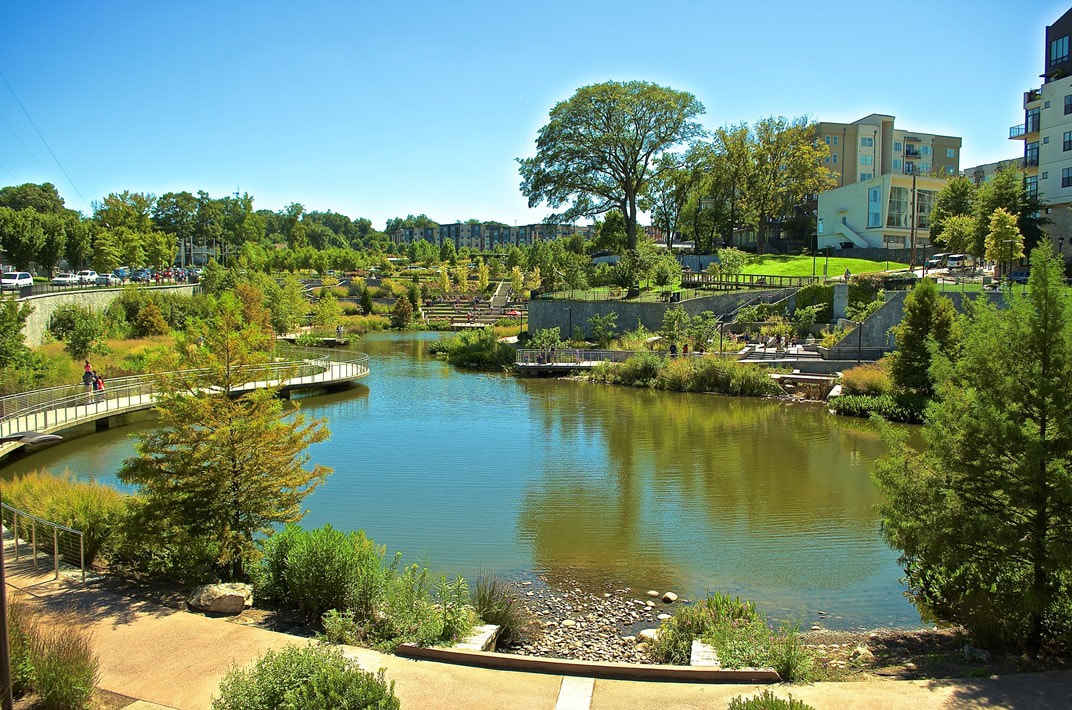Green Infrastructure Series: Atlanta GA
8/30/2017

Historic Fourth Ward Park 2005 - 2015; photos from Historic Fourth Ward Park Conservancy
Atlanta, GA is mostly on a combined sewer system. In 1999, the City of Atlanta signed a consent decree with the EPA to manage its chronic CSO issues. The City proposed a 15-year $3 billion plan to construct a CSO tunnel and sewer separation in selected areas. While grey infrastructure has been at the forefront of Atlanta's CSO mitigation plans, a major green infrastructure project in the Old Fourth Ward neighborhood is contributing to Atlanta's CSO reduction goals.
The Historic Fourth Ward Park, just Northeast from downtown Atlanta, is a new 17 acre park with a 2 acre detention pond that diverts stormwater from entering the combined sewer system. Before the park was constructed, the Fourth Ward was subject to intermittent flooding and sewer overflows. As part of its 2001 plan for sewer system improvement, the City initially planned to build out a tunnel extension of the combined sewer system. In 2003, a stormwater activist developed a plan to turn this brownfield site into a park. After nearly a decade of planning, land acquisition and finally construction, the historic Fourth Ward Park was completed in 2011.
The park is a stormwater detention basin that manages stormwater in the 800-acre drainage basin for Clear Creek. There is a permanent pool of water in the pond that takes on stormwater runoff from up to a 100 year storm. The water is detained during a storm and slowly is released into the Highland Avenue Combined Sewer Trunk, where it would eventually be treated at a wastewater treatment plant. Other features in the park are a fountain using captured stormwater within the pond, a skate park designed by Tony Hawk, and an amphitheater. The park has been a major amenity for the community and visitors, and has spurred economic development along the beltline, all while advancing the City's ability to meet Federal Consent Decree requirements. Furthermore, the creation of a detention pond instead of a CSO tunnel helped the city save more than $5 million in infrastructure costs. The park also borders the Beltline Greenway, a 22-mile multi-modal loop currently underway in Atlanta.
Visit the Historic Fourth Ward Park Conservancy's website for more information about the park and its history.

It's important to acknowledge the history of the neighborhood where this massive infrastructure project took place. The Fourth Ward was historically an African-American community and the birthplace of Martin Luther King Jr. What was previously dilapidated buildings and industrial contamination has been transformed to upscale residential development. There have been rising concerns that the existing residents will be pushed out, especially as the Beltline project progresses and housing becomes unaffordable. There is much more discussion on the Beltline and gentrification, starting with this article. Gentrification has been an ongoing concern for Atlanta and cities all over the country that are facing resurgence and increased popularity. While housing and affordability is beyond the scope of NYC Soil & Water Conservation District's work, it is crucial to recognize the importance of comprehensive planning and creating public spaces and environmental amenities that are accessible to everyone.
Atlanta has many other green infrastructure projects, including a green roof on City Hall and a solar PV + rainwater harvesting + green roof on the Southface Energy Institute. Next time you're in Atlanta, check out some more green infrastructure projects from the City's Self-Guided Green Infrastructure tour guide.
